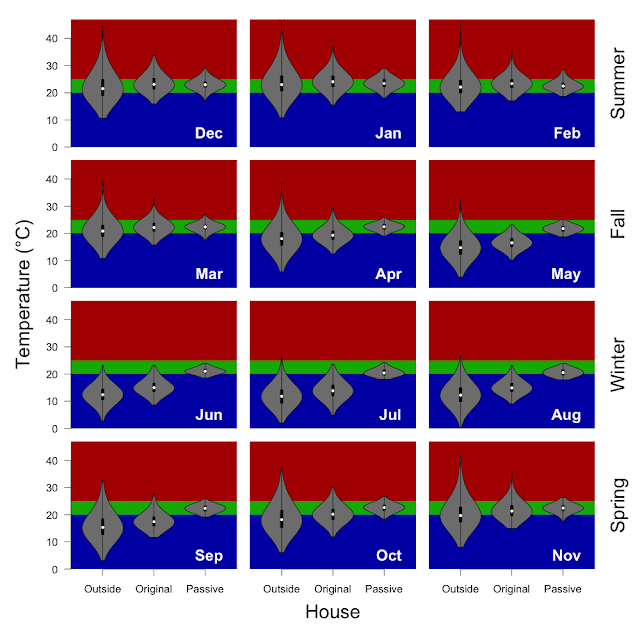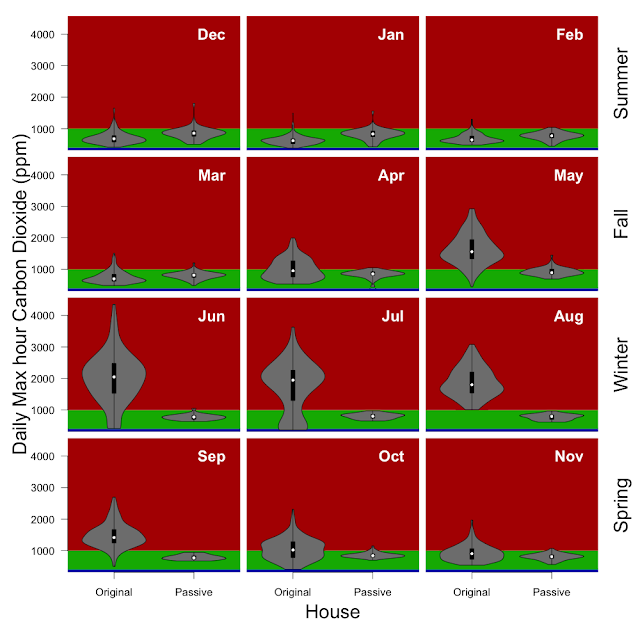FAQ on building and living in a certified passivhaus...
I went to the Australian Passivhaus Association sponsored open house at Asquith Passivehaus on Friday and it was great fun to catch up with about a hundred people into passive houses. At these gatherings if people discover that I live in a passivhaus then they always ask about the money and the stress associated with choosing to build a certified passivhaus.
Stress associated with the decision to build a certified passivhaus:
Deciding to build a house is a big decision. The choice to build a passive house was the least stressful or difficult choice we made when building our new home. It doesn't dictate a particular style for the house - it is about meeting an efficiency standard - which can stress out your architect and builder, but the the owner! Deciding to build a certified passive house made the process less stressful because of the added certainty of how our new house would perform was so much less... someone with far more knowledge than I possess was going to double check all the critical design and build decisions - that was a huge relief!
Picking all those subjective style things was stressful: flooring, tiles (bathrooms & kitchen), taps (for each and every sink), wall / ceiling / exterior / exterior trim / roof colours (so much easier to paint almost all of it white), lights (and so many different lights), towel & toilet paper holders, appliances, etc... those were stressful decisions. Not to mention having to negotiate with your partner when you are in 100% agreement on everything.
Deciding to build a passive house was the easiest choice we made in the whole process.
Costs associated with the decision to build a certified passivhaus:
Oh, the death by a thousand cuts and decisions! Even with a fixed price contract to build there are owner supplied items like tiles, taps, appliances and joinery that can have a bigger impact on the amount you will spend on the house you build than the choice to build a passive house (example: it is easy to spend anywhere between $40 and $400 per metre square for tile). The cost difference in a passive house occurs two places:
- Planning - your architect / designer has more work to do to make sure that your house will meet the passive house requirements. This is money well spent and you will benefit from this for the life of your home. Yes, it is more expensive than picking a set of existing plans from a project builder. Yes, it may be expensive to have any random architect design you a house. But once you have someone design your home - the extra to make that house a passive house isn't much extra - or at least is probably less than some of the other choices you're making along the way.
- Building - your builder has more work to do to make sure that the house that is built meets the required specifications (especially air tightness). I have always viewed the money spent to achieve certification as an insurance policy towards build quality. We had a great builder, but you never know that until the end! That said - the passive premium applies to the building envelope (especially the windows). Once you're working on the interior finishing, there isn't really a difference between a passive and any other house.
- Return on investment - People tend to forget about this when calculating the cost. Planning and building are one time upfront costs... that ensure the on going operating costs are low... for the life of the building. I am sure that someone could do that math, but much like my solar panels that cost me money up front... these are investments that yield returns. In the case of passive house - it is about the cost of running, but it is also less intangible things - what is price you put on consistent supplies of clean air? I looked at the HRV filters after the bush fires -- it didn't keep out all the smoke, but it kept a lot of it out. In our passive house: it is quiet (even next to the train line), a comfortable temperature, and the carbon dioxide levels are consistently below 700ppm, whereas in our old house on the same location: if we closed the windows to attempt temperature control, we routinely had CO2 levels over 1500ppm and we wore beanies and jackets at breakfast during the winter!
The other questions that are always asked:
- What is the downside of living in a passive house? Needing to consult the weather before you get dressed. My children consistently leave the house only to return to grab a jacket or change into shorts... as it is warmer / cooler than they dressed for!
- What would I do differently if I did it again? Not much. I would definitely build a passive house again... I even like the taps, tiles, appliance we choose. The things I would seriously think about all have tradeoffs and none of them relate to the fact we live in a passive house... and I could guarantee that you facing the same choice might choose something else entirely simply because of the house you want to live in.
- What do I need to make sure happens with my house? You need to understand what you are actually planning to build - this is true of any house not just a passive house. This seems trivial, but translating blue prints into a mental vision of your house it not easy. Visualising the view from the window shown on the plan... not easy. I am actually okay at interpreting plans, but I drew our house on the ground with builders string so that my partner and I could walk through a tangible space (albeit without walls). There were still a few things I had not managed to really wrap my head around. If you understand what you are planning to build then you are likely to be happy with the result. We had nearly no changes between what was contracted and what was built. That was good for us (didn't get socked with extra costs when changing things) and good for our builder (things only needed to be done once). Since you want to ask: we did change the way the shade sail attached to the back of house -- so I do have 3 stainless steel eyebolts in a box...


